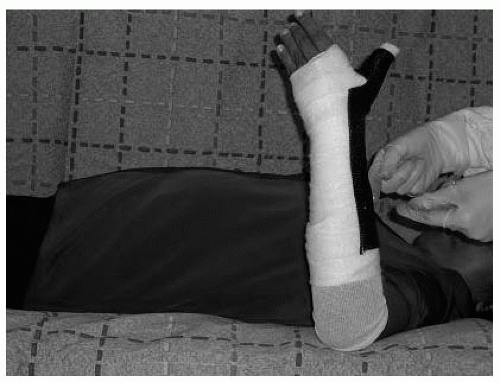Common Emergency Procedures
Angelo Mikrogianakis
Christina Ricks
Procedures
Orthopedic splints
Laceration repair: suturing and glueing
Lumbar puncture
Chest tube insertion
Orthopedic Splints
Materials
Stockingette, webril, plaster, kling wrap, flannel, water (cast setup)
Instructions for All Splints
Position patient
Place stockingette over extremity (measurements should be taken on unaffected side)
Wrap extremity in webril: extra padding is needed over bony prominences
Dip measured plaster (10 layers) in water and squeeze out excess
Place plaster over affected extremity, wrap with kling and mold into proper position. If second layer of plaster (tong or stirrup) needed for reinforcement around joints, mold first layer, then apply stirrup, wrap in kling, and mold second layer.
Finally, wrap completed splint in flannel. Secure with tape for a nice-looking cast.
Table 62.1 Orthopedic Splints | ||||||||||||||||||
|---|---|---|---|---|---|---|---|---|---|---|---|---|---|---|---|---|---|---|
|
Instructions for Specific Splints
Volar Splint
Begins at MCP joints and courses along volar surface of forearm to mid forearm, covering ulna and radius
Position child supine on bed with elbow at 90° or child may sit with fingers pointing up and elbow flexed 90°
Mold plaster with wrist in neutral position and fingers flexed at all joints
Sugar Tong, Forearm Splint
Should cover ulnar and radial edges of forearm and course along dorsal surface from MCP around elbow to palmar crease
Place child prone with affected arm hanging toward floor and elbow flexed 90°, or sitting with elbow flexed 90°
Sugar Tong, Humeral Splint
First place long arm splint
Sugar tong: splint from acromioclavicular joint around elbow, ending just distal to axilla
Place child in sitting position, elbow flexed 90°, and humerus internally rotated
Thumb Spica Splint
Position arm with elbow resting on bed
Splint should wrap around thumb and extend along radial side of arm to mid forearm
Wrist should be in neutral position with thumb abducted and MCP and PIP in slight flexion as if holding a cup
Ulnar Gutter Splint
Position arm with elbow resting on bed at 90°
Splint wraps around ulnar surface from DIP of 5th digit to mid forearm.
Cotton padding should wrap around 4th and 5th digits. Place additional cotton padding between digits for comfort.
Splint should be molded with wrist in neutral position and MCP and PIP in 70° and 30° of flexion, respectively
Long Arm Splint
Should extend from dorsal surface of upper arm, down around elbow, along ulnar surface of forearm to palmar crease
Child may lie prone with arm hanging over bed and elbow at 90°, or sitting on bed with elbow at 90°
Mold plaster with elbow at 90° and wrist in neutral position
To reinforce splint, place humeral sugar tong splint over long arm splint
Short Leg Splint
Should extend from fibular neck to proximal toes, covering dorsum of lower leg
Position child prone on bed with knee flexed and foot extended toward ceiling
Mold splint with ankle at 90°. May strengthen splint by applying a stirrup (sugar tong) splint. Stirrup should wrap around heel of foot and extend up to mid lower leg, bilaterally
Give crutches to those 6 years and older, with instruction
Long Leg Splint
Consider orthopedic consult as growth disturbances are common around knee
Should cover posterior aspect of upper and lower leg extending from proximal thigh to heel distally
Place child prone on bed with leg in position of comfort, or supine with someone supporting leg
Mold plaster with knee in slight flexion and ankle in neutral. May need reinforcement around knee to prevent cast from cracking
Give crutches to those 6 years and older, with instruction
Laceration Repair: Suturing
Superficial: a superficial laceration is restricted to the epidermis
Deep: a deep wound extends beyond epidermis into dermis
Sutures
Absorbable:
Two most commonly used are surgical gut and Vicryl
Absorbable sutures should be used in subcutaneous closure
Rapidly absorbing sutures may be used on certain facial lacerations, especially in small children, and if difficult removal of sutures
Nonabsorbable:
Commonly used sutures are nylon, polyester, and polypropylene
Stay updated, free articles. Join our Telegram channel

Full access? Get Clinical Tree






